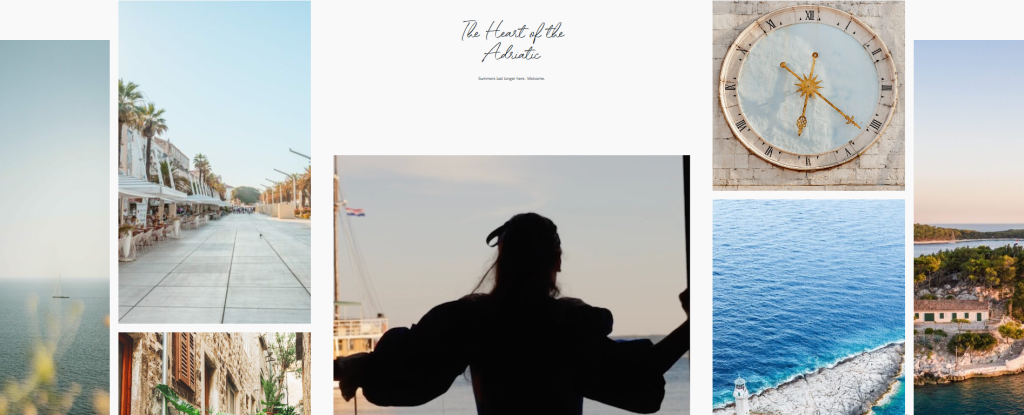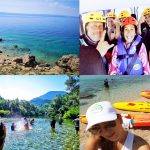January 12, 2024 – Sustainability and tourism – the buzzwords. Inland central Dalmatia? Yet to be discovered. An empty canvas of sorts, up and coming for sure.
“These days we leave the keys locked behind a code, the host does not get to know the guests – that’s how we stop being hosts and open up a whole series of problems”, points out Ivana Vladović, director of the Split-Dalmatia County tourist board. In a conversation on the topic of sustainability in tourism, she emphasizes:
“Dalmatia is self-sustaining by nature. Every honest Dalmatian house has long had that black water heater in which you shower outside, there is draft instead of air conditioning, homecooked food… We have forgotten who we are.”
The topic of sustainable tourism is much more than a mere definition and has many dimensions. But it is precisely in Split-Dalmatia County that we can single out positive examples, notes hrturizam.
One is the Green Line, and the other is the Dalmatian Brunch. During the conversation, Vladović did an excellent job of pointing out the fact that it happens that guests come to experience something that they are not and that the offer needs to be amended.
Destinations create their narrative and the story – they are the actual narrators.
Some of the guests visit just for the room and the entertainment, not for the housekeeping and brunch, emphasizes Vladović and adds:
“It’s a big job. In cooperation with Split-Dalmatia County and their project Ambassadors of Tourism, we started branding family tourism, wanting to bring back that intimacy and direct contact with the host. To show the Dalmatian way of life. Unfortunately, the rentierism that happened in the meantime is a huge drawback on that path, but let’s not forget that the guests’ habits have changed. They come to us for something we are not, because that’s what we offered. We have adapted to the guest as much as possible and we are slowly losing authenticity – and that is our fault. We have to correct the quality of our offer.”
The new Tourism Act puts decision-making down to the destinations. This is great news, because it is the destinations themselves that develop tourism. And until now, they did not have the tools to deal with development in the right way.
“The new Tourism Act obliges us to see what the tourist flows are like, to come up with real and realistic plans and then, based on them, decide which activities lead us to sustainability. There is no success without cooperation with the local community, the ministry and everyone in the chain. We all need to pull in the same direction, from tourist boards, cities, counties, and entrepreneurs. We all have to have the same goal.
We are lucky that our county strategy focuses on a green and sustainable future. And that’s why there are many such activities that we do, both in the tourist board and the County. If there is no domestic population, there is no story about sustainability. Then we are no longer ourselves. If we do not have interested and motivated entrepreneurs in tourism, we are gone again. If there is no sustainability in terms of energy, we are gone again. Education is extremely important and the beginning of everything. We have to change our own mindset.
If we want the future, we must be green. Let’s start with ourselves. Lifelong education of every resident for the future, from kindergartens, owners of family accommodation, public sector… to all local residents. It is the future of the world, it is not only the future of tourism.” states Vladović.
Numbers are constantly counted as KPIs of our success, which in itself is not sustainable. When asked how to move away from just counting tourists, Vladović points out that sustainability and counting tourists are not a sign of equality between them.
“We have to count experiences and beauty. !e keep saying let’s not look at the numbers, but every so often the question how many tourists visited pops up. As soon as the number drops a little or there are 1-2% fewer tourists, it is immediately seen as if the season has failed. Sustainability and counting are not a sign of equality between them. We have to work on the quality of guests, turn to the guests we want and give them what they want. We must direct our campaigns in the pre- and post-season to high-quality guests who expect a high-quality offer in our destination. We underestimate ourselves. All of Croatia is so fantastic, our product is phenomenal, we are afraid to consistently show what we really are. We are special in every way, from historical heritage, and lifestyle to gastronomy. I believe that with the right campaigns and message targeting, we will make a breakthrough.” says Vladović.

Two Sustainable Tourism Development Projects
Two examples of sustainable tourism development were mentioned above. The first is a tourist bus line – the Green Line which departs every day at 12 p.m. (from April 1 to October 31) from the Split waterfront towards Dalmatinska Zagora (inland Dalmatia). This is a move of redistribution of tourists towards the inland, i.e. the rural area, which is full of amazing tourist stories and experiences.
This year, the Green Line will run twice a day. The morning line goes to the Dugopolje Visitor Centre, where they are picked up by agencies that organize trips around Dalmatian Zagora (outdoor activities – rafting, kayaking, walking, bicycles, quads; gastro tours, religious, historical, etc.), and the afternoon one returns to Split via Klis and Stella Croatica via Salona.
The second project is the Dalmatian brunch, which aims to connect restaurants and family farms and, above all, promote an authentic offer. The way it should have always been, had Croatia not been wandering around in the area od tourism development. This is all about the Dalmatian identity, the way and culture of living that no one should be ashamed of. On the contrary, it should be at the heart of the tourist product.
Dugopolje becomes a reception point for excursions to Inland central Dalmatia
Dugopolje is becoming a reception point for guests who go on further excursions around inland central Dalmatia, announced Vladović, whether this is water sports such as kayaking and rafting, quad tours or gastro tours.
An excellent example of adding a new dimension to the Skrivena Dalmacija (Hidden Dalmatia) visitor centre as well as targeting tourists, i.e. building a whole system around Dugopolje as an event centre. The key thing is that the Green Line brings guests specifically to the Visitor Centre in Dugopolje. The agencies present an offer of active tourism in inland Dalmatia and accept guests there, and it is all connected by the Green Line, which arrives in the afternoon, and guests return via Klis and Stella Croatica in Split.
“So now we have the option of staying in the Split hinterland for several days,” emphasizes Vladović and adds that the goal of the Green Line was to relieve the centre of Split from crowds and show the added value of the destination.
“From the centre of Split, we take guests on panoramic buses to the “Gate of inland Dalmatia”, i.e. the “Hidden Dalmatia” visitor centre in Dugopolje, which is attractive, modern and interactive, and precisely shows hidden Dalmatia primarily in the story of nature and history. Then we go to Klis and the Klis fortress, then to Stella Croatica, where guests can experience olive oil processing and an olive museum, with a botanical garden, a story about the Dalmatian flora and, of course, taste some authentic Dalmatian dishes at the end. After that we move towards Salona. Agencies involved in the project offer outdoor activities, i.e. programs in rural areas, i.e. those activities that we want to promote and develop in a targeted manner.”
An excellent example of how a destination is strategically developed. The county and the Tourist Board in collaboration with the private sector (agencies, bus operators, restaurants, guides) are developing a targeted tourist product to reduce the burden on Split, but more importantly, focusing on rural areas and offering something new and different.
The whole project proved to be sustainable even after the first summer season, although it is realistic to count on a period of at least three years in such projects, which is great news as well as another example of how, through the cooperation of the public and private sectors, a new tourist product can be launched and tourist traffic redirected, which may not have been in commercial focus until now. Let’s be honest, it’s always easier to sell the coast.
“The whole project already proved to be financially viable this year, the partner who has the buses, the agency, the Visitor Centre, Klis Fortress and Stella Croatia is satisfied. So is the entire chain. Also, at the end of July, we added a new line – Klis Sunset – a unique sunset, and the results were fantastic. So we decided that this year we will introduce two lines permanently, from April to November, every day,” says Vladović.

Dalmatian brunch as a new gastronomic product of Dalmatia
Let us be what we are – is the sentence with which Goran, the author started his first blog and which has followed him ever since. The Dalmatian brunch project is exactly that.
On the other hand, it is a very challenging project to conduct from today’s perspective, because again it is easiest to sell “pizzas, kebabs, calamari, bolognese” or to simply buy food in any commercial chain.
It will certainly take a long time for the project to come to life on the market, and be self-sustaining. But again, the role of the Split-Dalmatia tourist board is crucial here, which is also the primary task of tourist boards – the development of new tourist products. Especially since tourist boards do not have an imperative to make money and can develop the project for a long period with various resources until it becomes self-sustaining.
The main question is how to make catering establishments aware of the fact that they are involved in this project. Communication, communication and the main motive – financial interest.
When asked how the project went in the first season, Vladović pointed out that she was very satisfied, and all the more so because the agencies were delighted with the new product.
“We decided on a strategy of not pulling anyone’s sleeve – whoever recognizes it is with us in the project. But I must be very proud that this year when we presented the new destination website, we also awarded the first chefs who joined the Brunch project. So we have about 15 chefs, from inland Dalmatia, the islands and on the coast, who immediately got involved in the project. So the Dalmatian brunch is offered in facilities in Split, Sinj, Maskarska, Marina, Hvar and Brač – we have great examples in practice that have already come to life. We will work intensively to strongly promote all those who are part of that project because our goal is to show what we are, as you emphasized. What we always say – authenticity; and Dalmatian brunch is our reality and our authenticity. Even though people don’t go to brunches as much as they used to, the brunch mentality still exists here,” Vladović points out and emphasizes that they want to show the market the best of what they have and what they usually keep for themselves.
The project is conceived in two segments – hospitality offer and connection of procurement chains, and everything is rounded off by the tourism product of Dalmatia gastro tours.
“One segment is caterers who offer brunch, and the other segment is the use of local producers and products. So we will brand restaurants, but also products with a special certificate. Caterers, small producers, winemakers, oil producers, and agencies are invited to this project to do gastronomic tours of Dalmatia. In this sense, we also made a series of documentaries, which tell the story of brunch, not only as a gastronomic experience but as an experience of Dalmatian life. We combine culture, art and food.” concludes Vladović.
As the author concludes, let’s be who we are, not copies. This is the greatest value and comparative advantage. Who wants to see and experience a copy? On the other hand, he points out, this is one of the main pillars of sustainability. Because without people, preserved spaces and an authentic way and culture of life, there is no future.
Finally, enjoy this Dalmatian brunch video.










